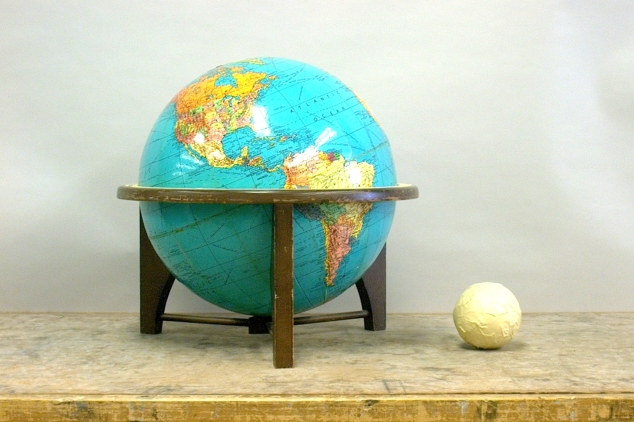

(Thanks to Hugh O’Neill for inspiring this demonstration.)
The globe is 16 inches in diameter (Weber Costello Executive, 1:31,680,000 scale), and the ball at right is four inches in diameter. The ball is a polypropylene sphere covered with masking tape to simulate the rough surface of the moon. This size relationship is close to that of the Earth and Moon, whose radii are in a ratio of 1:0.2727 (6,371.0 km vs. 1,737.1 km, volumetric mean radius). The mean Earth-Moon distance at opposition (i.e., when relative to the Earth, the Moon and the Sun are opposite each other) is 378,000 km. The Earth’s diameter is 12,742 km, which makes the Earth-Moon distance about 29.7 Earth diameters. For a 16-inch globe, this is about 29.7 × 1.33 feet, or about 39.4 feet (39′5″). You can find data on the physical properties of the earth-moon system here.
The front of Broida 1610 is about 52 feet wide, and the lectern is seven to nine feet from the wall. You can set the globe on a projector table or cart, and place the ball on top of the lectern. If you then wheel the cart to about three feet from the opposite wall, they will be approximately the right distance apart to form a scale model of the Earth-Moon system. The floor tiles are one-foot tiles, so you can count about 39-and-a-half tiles from the center of the moon to the center of the earth, and it will be close.
Broida 1640, unfortunately, is not nearly as large. At the front, it is only about 29 feet wide, and from the center of the back wall to the chalkboard frame it is approximately 41 feet, 5 inches. From the top of the lectern to the opposite rear corner is about 43 feet, so if you put the Moon on the computer lectern and the Earth on a stand on the landing at the opposite rear corner, they should be about the right distance apart. Alternatively, you could place the Moon on the sill of the window of the projection booth, and the Earth on a stand just behind the demonstration table, which should also give about the right distance.